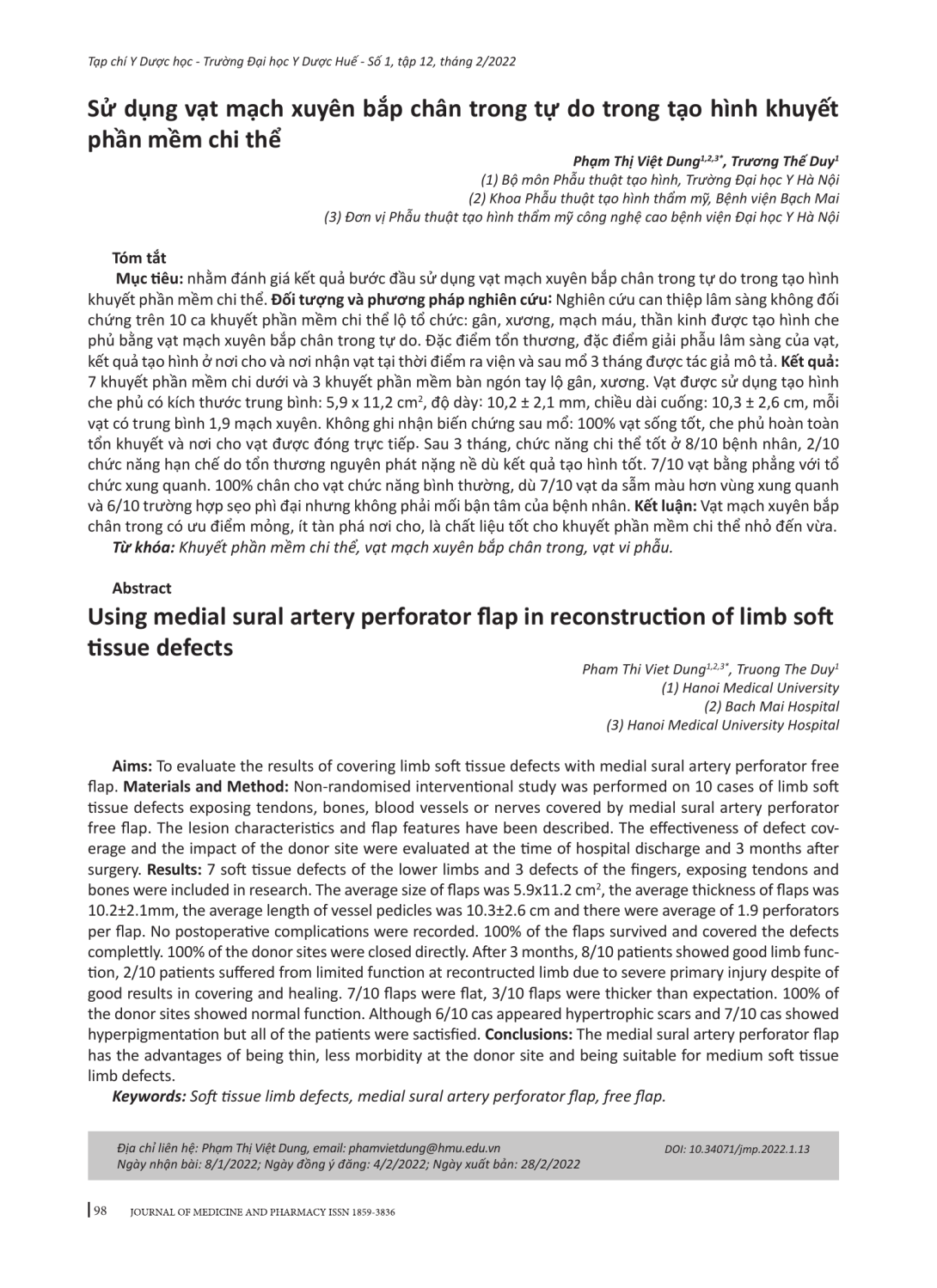
Đánh giá kết quả bước đầu sử dụng vạt mạch xuyên bắp chân trong tự do trong tạo hình khuyết phần mềm chi thể. Đối tượng và phương pháp nghiên cứu: Nghiên cứu can thiệp lâm sàng không đối chứng trên 10 ca khuyết phần mềm chi thể lộ tổ chức: gân, xương, mạch máu, thần kinh được tạo hình che phủ bằng vạt mạch xuyên bắp chân trong tự do. Đặc điểm tổn thương, đặc điểm giải phẫu lâm sàng của vạt, kết quả tạo hình ở nơi cho và nơi nhận vạt tại thời điểm ra viện và sau mổ 3 tháng được tác giả mô tả. Kết quả: 7 khuyết phần mềm chi dưới và 3 khuyết phần mềm bàn ngón tay lộ gân, xương. Vạt được sử dụng tạo hình che phủ có kích thước trung bình: 5,9 x 11,2 cm2, độ dày: 10,2 ± 2,1 mm, chiều dài cuống: 10,3 ± 2,6 cm, mỗi vạt có trung bình 1,9 mạch xuyên. Không ghi nhận biến chứng sau mổ: 100% vạt sống tốt, che phủ hoàn toàn tổn khuyết và nơi cho vạt được đóng trực tiếp. Sau 3 tháng, chức năng chi thể tốt ở 8/10 bệnh nhân, 2/10 chức năng hạn chế do tổn thương nguyên phát nặng nề dù kết quả tạo hình tốt. 7/10 vạt bằng phẳng với tổ chức xung quanh. 100% chân cho vạt chức năng bình thường, dù 7/10 vạt da sẫm màu hơn vùng xung quanh và 6/10 trường hợp sẹo phì đại nhưng không phải mối bận tâm của bệnh nhân. Kết luận: Vạt mạch xuyên bắp chân trong có ưu điểm mỏng, ít tàn phá nơi cho, là chất liệu tốt cho khuyết phần mềm chi thể nhỏ đến vừa.
To evaluate the results of covering limb soft tissue defects with medial sural artery perforator free flap. Materials and Method: Non-randomised interventional study was performed on 10 cases of limb soft tissue defects exposing tendons, bones, blood vessels or nerves covered by medial sural artery perforator free flap. The lesion characteristics and flap features have been described. The effectiveness of defect coverage and the impact of the donor site were evaluated at the time of hospital discharge and 3 months after surgery. Results: 7 soft tissue defects of the lower limbs and 3 defects of the fingers, exposing tendons and bones were included in research. The average size of flaps was 5.9x11.2 cm2 , the average thickness of flaps was 10.2±2.1mm, the average length of vessel pedicles was 10.3±2.6 cm and there were average of 1.9 perforators per flap. No postoperative complications were recorded. 100% of the flaps survived and covered the defects complettly. 100% of the donor sites were closed directly. After 3 months, 8/10 patients showed good limb function, 2/10 patients suffered from limited function at recontructed limb due to severe primary injury despite of good results in covering and healing. 7/10 flaps were flat, 3/10 flaps were thicker than expectation. 100% of the donor sites showed normal function. Although 6/10 cas appeared hypertrophic scars and 7/10 cas showed hyperpigmentation but all of the patients were sactisfied. Conclusions: The medial sural artery perforator flap has the advantages of being thin, less morbidity at the donor site and being suitable for medium soft tissue limb defects.
- Đăng nhập để gửi ý kiến
